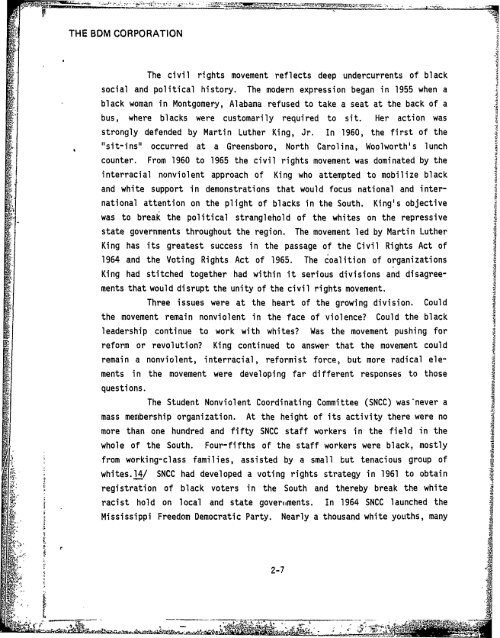policy - The Black Vault
policy - The Black Vault
policy - The Black Vault
Create successful ePaper yourself
Turn your PDF publications into a flip-book with our unique Google optimized e-Paper software.
THE BDM CORPORATION<br />
<strong>The</strong> civil rights movement reflects deep undercurrents of black<br />
social and political history.<br />
black woman in Montgomery,<br />
<strong>The</strong> modern expression began in 1955 when a<br />
Alabama refused to take a seat at the back of a<br />
"bus, where blacks were customarily required to sit. Her action was<br />
strongly defended by Martin Luther King, Jr. In 1960, the first of the<br />
"sit-ins" occurred at a Greensboro, North Carolina, Woolworth's lunch<br />
counter. From 1960 to 1965 the civil rights movement was dominated by the<br />
interracial nonviolent approach of King who attempted to mobilize black<br />
and white support in demonstrations that would focus national and international<br />
attention on the plight of blacks in the South.<br />
King's objective<br />
was to break the political stranglehold of the whites on the repressive<br />
state governments throughout the region. <strong>The</strong> movement led by Martin Luther<br />
King has its greatest success in the passage of the Civil Rights Act of<br />
1964 and the Voting Rights Act of 1965. <strong>The</strong> coalition of organizations<br />
King had stitched together had within it serious divisions and disagreements<br />
that would disrupt the unity of the civil rights movement.<br />
Three issues were at the heart of the growing division.<br />
Could<br />
the movement remain nonviolent in the face of violence? Could the black<br />
leadership continue to work with whites? Was the movement pushing for<br />
reform or revolution? King continued to answer that the movement could<br />
remain a nonviolent, interracial, reformist force, but more radical elements<br />
in the movement were developing far different responses to those<br />
questions.<br />
<strong>The</strong> Student Nonviolent Coordinating Committee (SNCC)<br />
mass membership organization.<br />
more than one hundred and fifty SNCC<br />
whole of the South.<br />
was-never a<br />
At the height of its activity there were no<br />
staff workers in the field in the<br />
Four-fifths of the staff workers were black, mostly<br />
from working-class families, assisted by a small but tenacious group of<br />
whites.14/ SNCC had developed a voting rights strategy in 1961 to obtain<br />
registration of black voters in the South and thereby break the white<br />
racist hold on local and state goveriments. In 1964 SNCC launched the<br />
Mississippi Freedom Democratic Party.<br />
Nearly a thousand white youths, many<br />
2-7<br />
L-
















